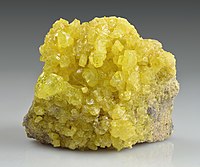
Photo from wikipedia
Abstract The 41K/39K reduced partition function ratios, 103lnβ, of 17 major K-bearing minerals have been calculated using the density functional theory (DFT) method. Their 103lnβ decrease in the order of… Click to show full abstract
Abstract The 41K/39K reduced partition function ratios, 103lnβ, of 17 major K-bearing minerals have been calculated using the density functional theory (DFT) method. Their 103lnβ decrease in the order of alunite (KAl3(SO4)2(OH)6) ∼ K-hollandite I (KAlSi3O8) > niter (KNO3) > potassium carbonate (K2CO3) ∼ potassium bicarbonate (KHCO3) > muscovite (KAl2(AlSi3O10)(OH)2) > potassium hydroxide monohydrate (KOH·H2O) ∼ hydrated potassium carbonate (K2CO3·1.5H2O) > nepheline (Na3KAl4Si4O16) > potassium hydroxide dihydrate (KOH·2H2O) > kalsilite (KAlSiO4) > microcline (KAlSi3O8) ∼ phlogopite (KMg3AlSi3O10(OH)2) > lepidolite (KLi2AlSi4O10(OH)2) > sylvite (KCl) > leucite (KAlSi2O6) > djerfisherite (K6CuFe24S26Cl). The calculated 103lnβ varies from 6.80‰ in alunite to 2.08‰ in djerfisherite at 300 K, and from 0.63‰ to 0.19‰ at 1000 K. At 1000 K, there is only small variation (
Journal Title: Geochimica et Cosmochimica Acta
Year Published: 2019
Link to full text (if available)
Share on Social Media: Sign Up to like & get
recommendations!